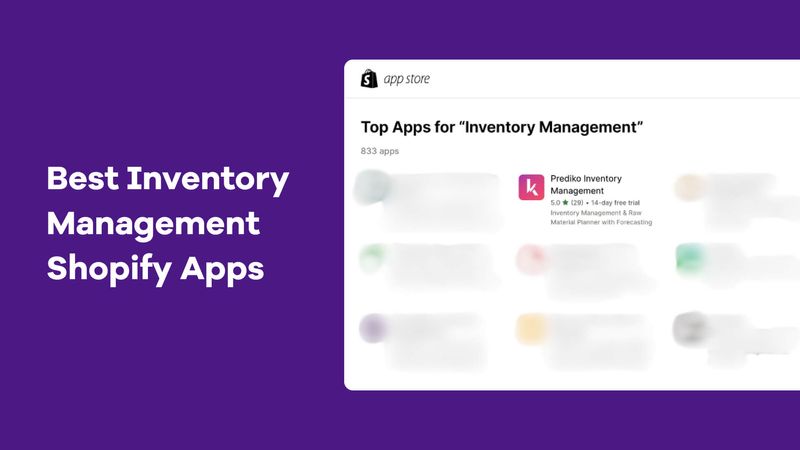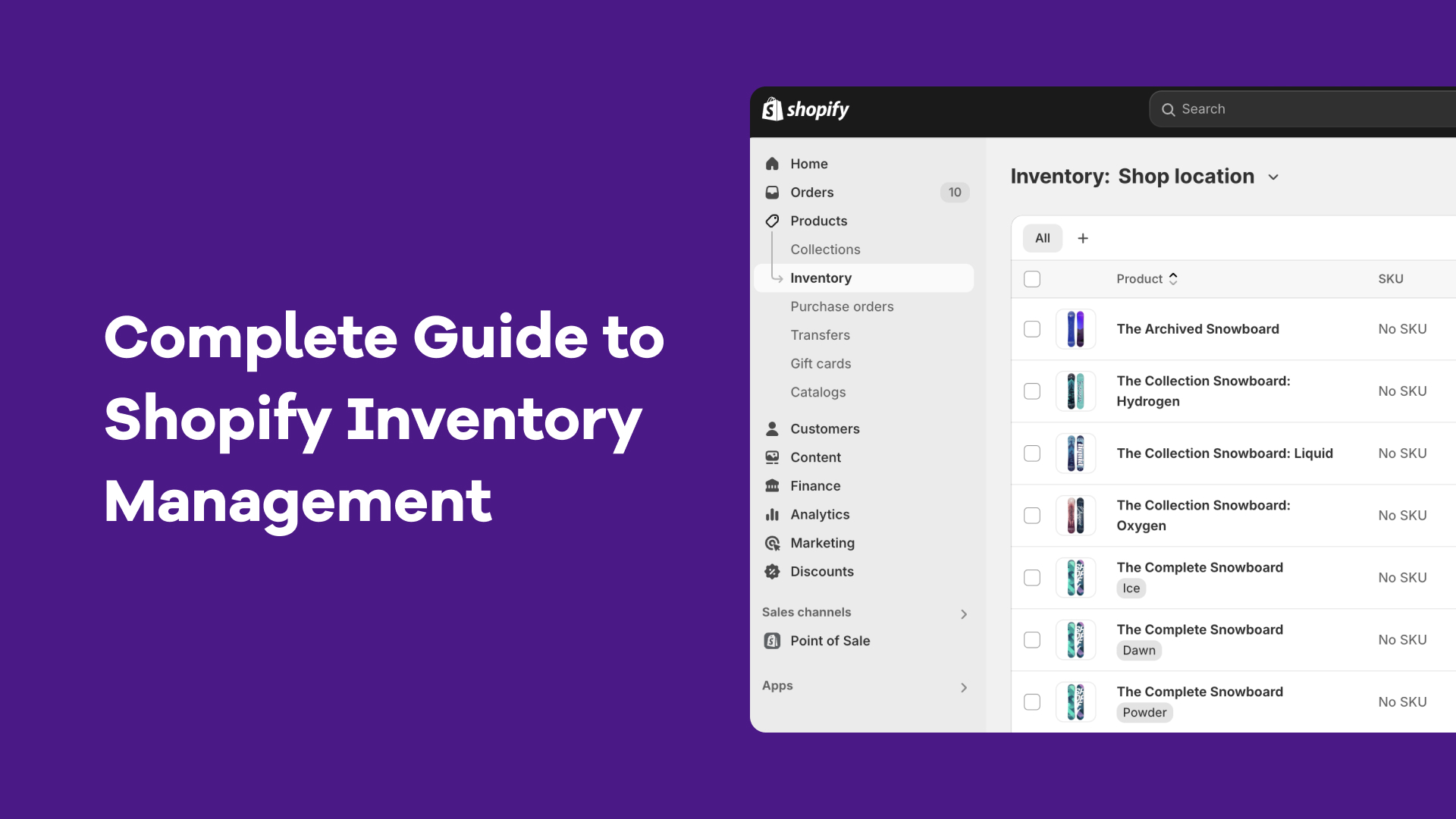In this fast-paced and competitive world of fashion retail, effective apparel inventory management is essential. This involves not only tracking stock levels but also accurately forecasting demand, preventing stockouts, and minimizing overstock. Implementing a smart apparel inventory management system can give you a clear forecast, help restock on time, and ultimately reach your revenue goals.
Implementing a smart apparel inventory management system can give you a clear forecast, help restock on time, and ultimately help you reach your revenue goal.
👉 Download Free Excel Template Inside
What is Apparel Inventory Management?
Apparel inventory management is the process of tracking and managing the flow of clothing products within a retail store or business to ensure that the right products are available at the right time.
Apparel inventory management includes tasks such as monitoring stock levels, reordering merchandise, tracking sales trends, and optimizing inventory processes to prevent stockouts and overstocking. Implementing an effective apparel inventory management system is essential for the success of clothing stores, as it helps streamline operations, maintain accurate inventory, and drive business growth.
Efficient apparel inventory management drives revenue growth, enhances customer satisfaction, and streamlines operations in retail environments. A well-managed inventory system ensures every product is accounted for, and inventory movement is tracked in real-time. In the fashion industry, where trends change rapidly, this is a critical component of business success.

Apparel Inventory Management Examples:
Different types of retailers benefit from specific inventory management approaches. For example:
- Boutiques might prioritize high-margin, limited-edition pieces, and track items by season.
- Fast fashion retailers need rapid turnover and typically track inventory by SKU to optimize for speed and volume.
- Luxury brands focus on quality control and may use perpetual systems to ensure high inventory accuracy and minimal loss.
Key Types of Apparel Inventory Management Systems
In apparel inventory management, understanding the main types of inventory systems can help businesses choose the best approach based on their needs and operational scale.
The four main types of apparel inventory management systems are:
1. Just-in-Time (JIT) Management: JIT inventory management aims to reduce carrying costs by receiving goods only as they are needed in the production process or for sale. This method helps minimize inventory holding costs and storage space requirements.
2. Materials Requirement Planning (MRP): MRP is a computerized inventory management system that helps businesses ensure they have the right materials available for production. It focuses on managing the production schedules based on demand forecasts and the availability of materials. This is directly related to raw materials management within the Inventory management system.
3. Economic Order Quantity (EOQ): EOQ is a formula-based inventory management system that helps businesses determine the optimal order quantity that minimizes total inventory costs, including ordering costs and holding costs. It aims to balance the costs of ordering and storing inventory.
4. Days Sales of Inventory (DSI): DSI is a measure of how long, on average, a business holds its inventory before it is sold. It helps assess the efficiency of inventory management by indicating how quickly inventory is being sold relative to the amount of inventory on hand. A lower DSI indicates more efficient inventory management.
Each type of inventory management system has its benefits and challenges, and the most suitable method depends on the specific needs and characteristics of the apparel business.
Which Inventory System is Most Used in Clothing Stores?
Many clothing stores prefer perpetual inventory systems for real-time tracking. In a perpetual inventory control system, inventory levels are continuously updated in real-time as goods are bought, sold, or used. Our system relies on your Shopify D2C store admin to track inventory levels accurately. We have also covered a list of the best fashion inventory software in Shopify.
Prediko is an example of a perpetual Inventory Control System.
Challenges in Apparel Inventory Management
The fashion industry presents unique fashion inventory control challenges due to its fast-paced nature, diverse product range, and rapidly changing trends. Here are some of the primary challenges:
- Seasonal Trends and Unpredictable Demand: Fashion trends change with each season, making it challenging for retailers to predict demand accurately. Without precise forecasting, stores may end up with excess stock of last season's items or stockouts of in-demand products, both of which can impact sales and customer satisfaction.
- High SKU Variation: Apparel inventory often involves managing a wide variety of sizes, colors, and styles, which can result in hundreds or even thousands of SKUs. Tracking and managing each SKU accurately is crucial to avoid overstocking or understocking, both of which can affect profitability
- Fast Fashion’s Rapid Turnover: In the fast fashion sector, products are designed, manufactured, and sold at a rapid pace. This fast turnover puts additional pressure on inventory management systems, as they need to keep up with new product launches and quick reorder cycles.
- Stockouts and Overstocking: Striking a balance between stockouts and overstocking is challenging, especially with varying demand across product lines. Stockouts can result in missed sales opportunities, while overstocking ties up capital and may lead to markdowns or waste, especially for trend-sensitive items.
- Supply Chain and Production Delays:Global supply chains can be unpredictable, with delays that disrupt stock availability. Apparel brands must factor in potential delays to keep products in stock, especially during peak demand periods like holidays or sales events - which is where a reliable apparel supply chain management software becomes critical.

Benefits of a Smart Apparel Inventory Management System
Some of the core benefits of using a smart apparel inventory management system for your brand:
- Enhanced inventory accuracy: A smart system keeps inventory data updated in real-time, which reduces human error and ensures that every item is accurately accounted for. This prevents issues like overselling and stockouts.
- Increased efficency in reordering: Efficient reordering processes ensure that your popular products are always in stock. Apparel brands can set up automated reorder points, which reduces the risk of missing out on sales due to unavailable items.
- How to take inventory of clothing: Conducting a successful clothing inventory audit involves more than counting items. Retailers can benefit from using barcode scanning for efficiency, along with regular audits to validate stock levels. This ensures that data in the system reflects actual inventory, minimizing discrepancies.
- Cost savings and reduced waste: By accurately forecasting demand, smart systems minimize the chance of overstocking or understocking. This approach leads to significant cost savings, as unsold items often result in markdowns or losses.
Also Read: Shopify Variant Inventory Tracker: Automate to Reduce Manual Oversight

How do clothing stores keep track of inventory?
Retail stores use different methods to keep track of their inventory.
Using a POS system to track inventory in real-time
A Point-of-Sale (POS) system is one of the most effective ways to manage inventory. It automatically updates stock levels whenever a sale is made, making it easier to track what’s selling well and what’s not.By using a POS system, stores can reduce errors, avoid over-ordering, and always have the right products available.
Organize inventory with barcodes and RFID tags
Barcode scanning and RFID (Radio Frequency Identification) technology help streamline inventory management.
- Barcode scanner allow employees to update stock levels with a quick scan, making checkout and restocking easier.
- RFID tags help stores track inventory without needing direct line-of-sight scanning. These tags send real-time location updates, making them useful for preventing theft and managing stock across multiple locations.
Set up automated stock alerts
Running out of popular items or overstocking slow-moving products can hurt a store’s sales. Automated stock alerts notify store owners when inventory is running low, so they can reorder on time.
By using these automated alerts, stores can manage their stock more efficiently and avoid lost sales due to stockouts.
Keep track of inventory across multiple locations
For stores that have both physical retail and online stores, keeping inventory synced is essential. An integrated inventory system helps businesses track stock levels across all sales channels. This also helps when managing returns—if an online customer returns an item, the stock is automatically updated, ensuring the store doesn’t reorder unnecessarily.
Key Features of Prediko for Apparel Inventory Management
Prediko offers features designed specifically for fashion retailers, helping them tackle all the industry challenges. Here’s how Prediko’s features stand out:
1. Real-Time Inventory Tracking
Real-time tracking is an important feature that allows retailers to monitor stock levels continuously. This ensures that inventory data is always up-to-date, facilitating accurate decision-making and efficient stock management. We have covered the list of top inventory tracking apps for Shopify brands. We continuously sync with your Shopify store to give you a real-time visibility into your stock levels.
2. Timely Reordering Updates
Prediko’s interactive Buying Table analyzes inventory levels and sales trends to suggest optimal reorder points. It even recommends “What to Buy,” “When to Buy,” and “How Many Units to Buy,” ensuring inventory is always balanced and well-stocked.
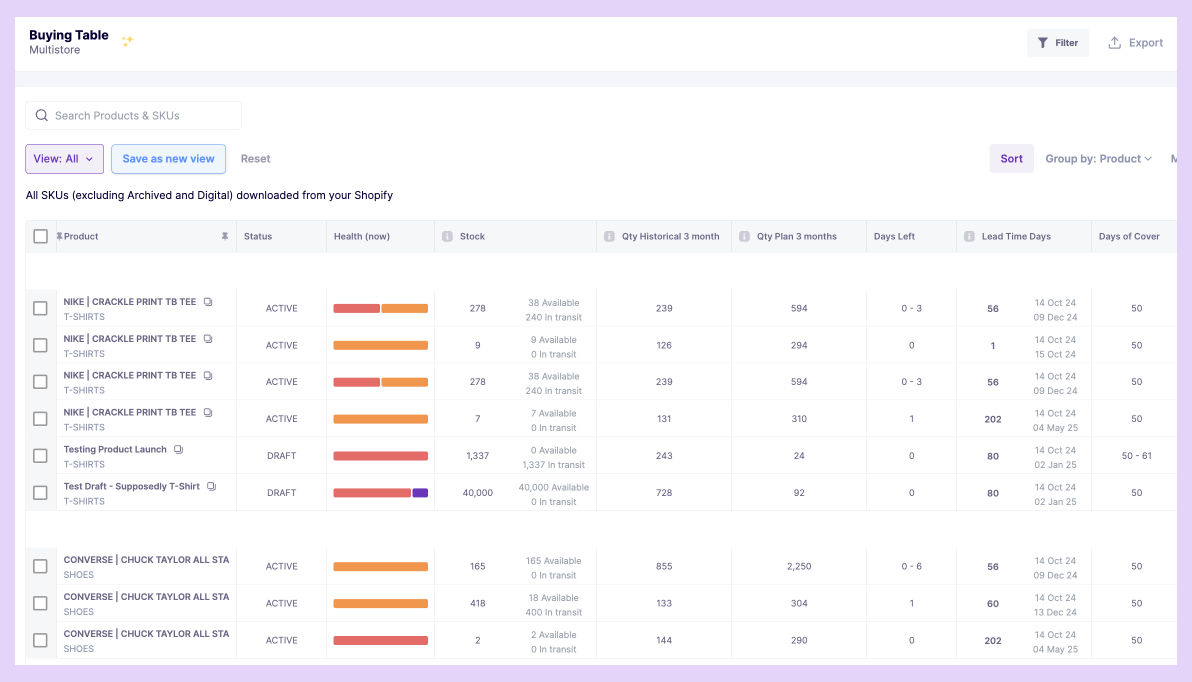
3. Our native demand forecasting
Prediko's AI based demand forecasting feature has been trained on 25 million+ SKUs across 15+ industries. Here is how our demand forecasting works:
- Prediko analyze Shopify store's historical sales data and look for seasonality and growth trends in that data
- This forecast refreshes based on your evolving sales targets- That's why we call it Prediko's Smart Plan.
Other parameters that we take into account when we generate the demand plan for apparel or fashion store inventory:
a) Popularity of certain SKUs
b) Black Friday and other seasonal campaigns
c) Launch effect- How a certain item behaved when it was launched.
d) Cannibalisation- Whether sales of one product impacts the other.
This enables retailers to make informed decisions about inventory purchases, minimizing waste and maximizing sales opportunities. Learn how to accurately forecast for your Shopify D2C brand.
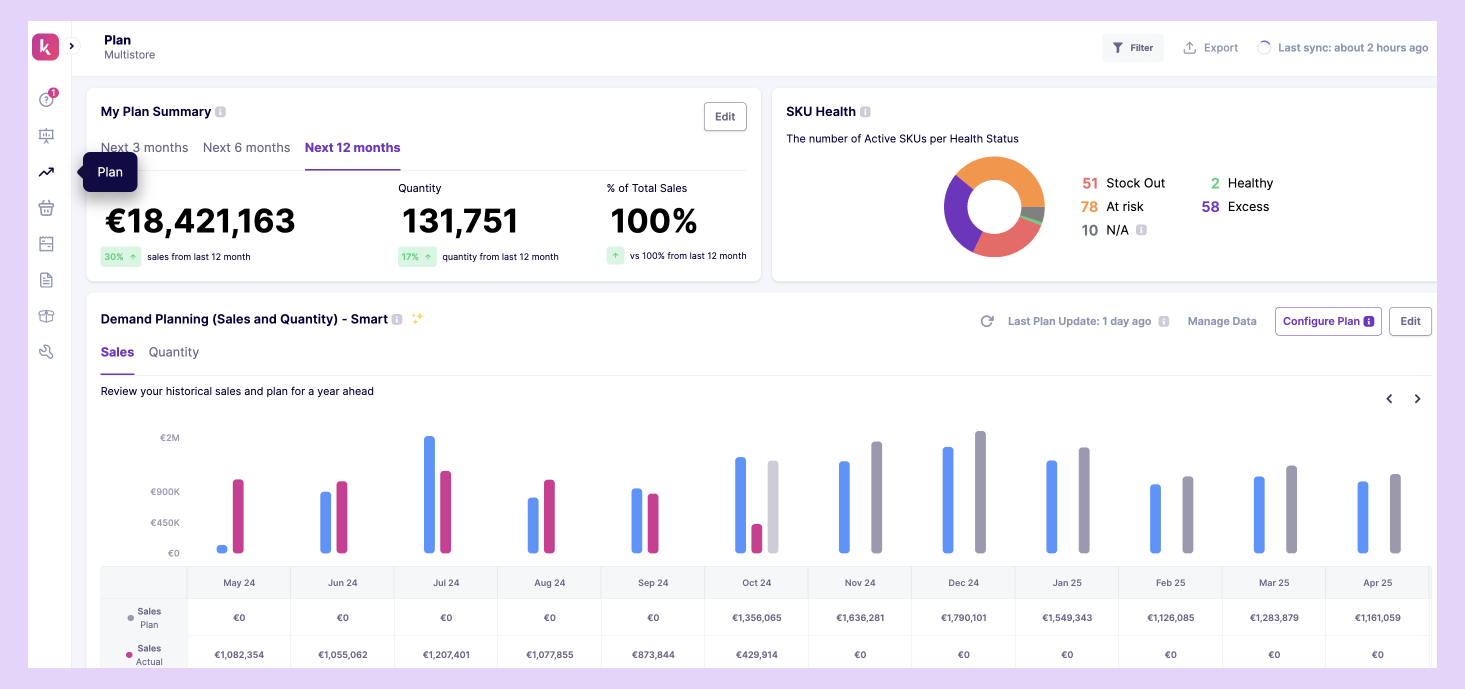
4. Advanced Analytics for Better Clothes Inventory Planning
For retailers, data-driven inventory planning and fashion specific analytics is essential to generating the right forecast.
Prediko’s dynamic buying table provides valuable insights that help businesses stay on top of
- Key Metrics:
- Sales Patterns: Learn which products sell best during specific times (e.g., seasonal trends) allows retailers to align stock levels with demand.
- Inventory Turnover Rate: This metric shows how quickly inventory is sold and replaced. A high turnover rate indicates effective stock management, whereas a low rate may signal overstocking.
- Sell-Through Rate: This measures the percentage of inventory sold during a set period and is particularly useful for managing high-demand apparel.
- Using Data for Strategic Replenishment: By analyzing historical data, Prediko enables retailers to predict demand more accurately and avoid common pitfalls like stockouts and excess inventory. For instance, fashion brands can use past Black Friday or holiday sales data to forecast needs for upcoming seasons.
- Visualizing trends: Prediko’s analytics dashboards make it easy to visualize data trends, helping retailers make informed decisions about which items to reorder, which to discount, and which to discontinue. This feature empowers fashion businesses to respond proactively to consumer trends, ultimately boosting profitability.

Choose the Right Apparel Inventory Management Software
Inventory needs in the apparel industry are different for different types of brands.
A fast-fashion brand launching new SKUs weekly operates very differently from a luxury label managing small-batch, high-value pieces.
That’s why choosing right software starts with understanding your business model and operational needs.
For fast fashion brands
Speed & agility define fast fashion. You’re turning trends into sellable stock in weeks, not months, so inventory system must
- Automate reorder alerts & replenishment workflows
- Handle large SKU counts efficiently
- Enable real-time data visibility across sales channels
- Offer strong demand forecasting to reduce overproduction
- Track performance by SKU category
Prediko, for example, is a good fit here. Its AI-powered demand forecasting, multi-store visibility, & quick PO workflows make it ideal for brands dealing with rapid stock turnover.
For Luxury Apparel Brands
Luxury fashion is about precision, not speed. Collections are released in seasons, each SKU carries high value, and the cost of inventory errors is much higher.
Your software should focus on:
- SKU-level visibility for precise reordering
- Forecasting that accounts for seasonality, exclusivity, and smaller sales volumes
- Integration with production needs and supplier lead times
- Analytics to track sell-through, profit margin, and slow movers
Luxury brands benefit from a planning-first inventory platform; one that connects forecasting with purchasing, lets you manage raw materials (if needed), and provides deep insights without overwhelming you with excess features.
Prediko works for luxury too, thanks to its accurate demand planning, reorder alerts, built-in raw material forecasting and tracking, and customizable reports.
For Luxury Apparel Brands
Luxury fashion is about precision, not speed. Collections are released in seasons, each SKU carries high value, and the cost of inventory errors is much higher.
Free Apparel Inventory Management Templates & Excel Spreadsheet
Templates can simplify the inventory process, especially for smaller brands or boutiques that need a user-friendly solution. To streamline clothing inventory stock management, retailers can utilize these templates created by Prediko.
Retailers can get started with a free inventory tracking sheet to manage apparel SKUs, sizes, and reorder levels without needing advanced software
1. Apparel Inventory Management Template
Customizable template that allow retailers to track apparel SKUs, sizes, categories, and quantities.
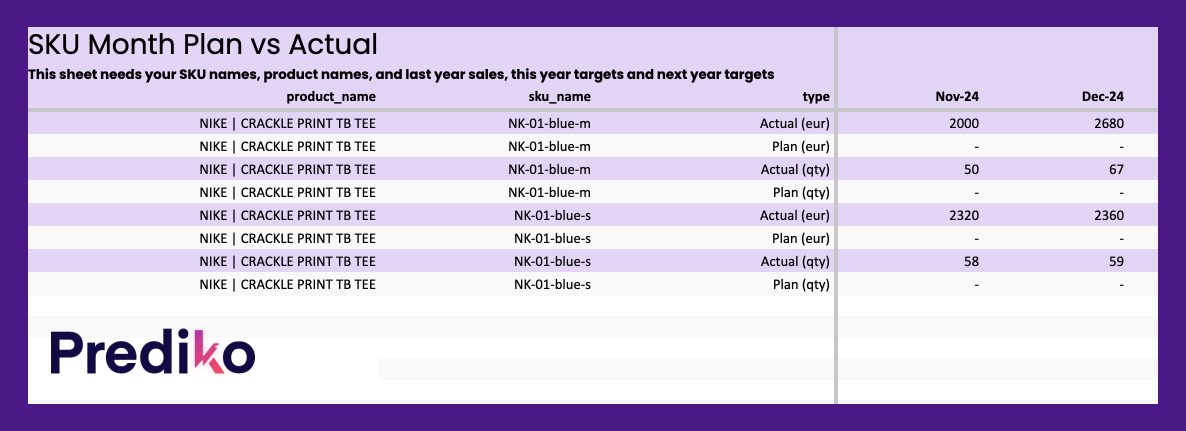
2. Clothing Inventory Management Excel and Spreadsheet
This excel template features columns for product ID, SKU, product description, quantity on hand, reorder level, and supplier details. Retailers can also add formulas to automate calculations, such as stock level alerts and reorder points.

Download this excel template in the form of an excel using the button above. You can download both of these spreadsheets as Excel files after copying the spreadsheet via File > Download.
Apparel Brands Boosting Inventory Efficiency with Prediko [Case Studies]
Prediko has helped several fashion brands optimize their inventory processes. Here’s how two retailers successfully tackled inventory challenges with Prediko:
1. Kate Hewko – Boosting inventory efficiency by 40%
Kate Hewko, a prominent fashion brand, was facing challenges with inventory inefficiency. After adopting Prediko’s Planning and Purchasing platform, the brand saw substantial improvements. With accurate demand forecasting for apparel products and streamlined procurement, Kate Hewko achieved a 40% increase in inventory efficiency. Prediko’s reporting tools allowed them to make more strategic restocking decisions, reducing both stockouts and excess inventory.

2. Cloudsharks – Reducing stockouts by 35%
Cloudsharks, a young eCommerce brand specializing in shark-shaped slides, struggled with managing a growing inventory of over 500 SKUs. Their previous system, Cogsy, didn’t support the level of demand forecasting they needed. By switching to Prediko, which integrates real-time sales volume with 12-month forecasts, Cloudsharks reduced stockouts by 35%. Prediko’s platform provided more accurate order quantities, significantly improving inventory management and enabling better customer service.
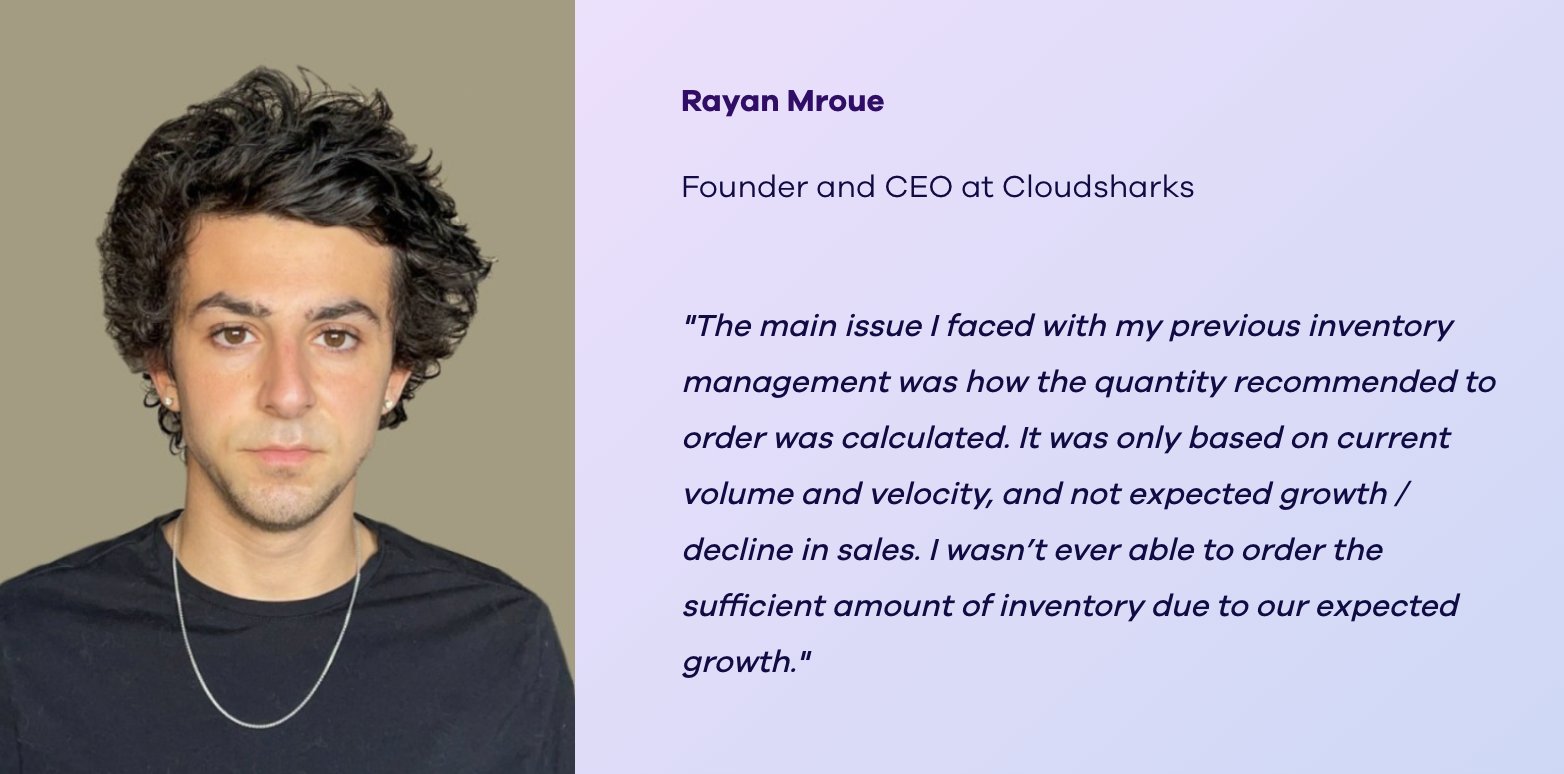
Choosing the Right Apparel Inventory Management Software
Selecting an inventory management system is a strategic decision that impacts daily operations, customer satisfaction, and long-term growth. Here are the main factors to consider:
- Scalability:
As your brand grows, inventory needs evolve. A clothing inventory management software like Prediko’s can manage thousands of SKUs across multiple locations, providing seamless transitions as your business expands. Look for systems that can handle increased volume without compromising on speed or accuracy. - Integration Capabilities:
It’s essential that your inventory management system integrates well with your existing software, including point-of-sale (POS) systems, eCommerce platforms, and accounting tools. Prediko’s native Shopify integration, along with third-party app support for platforms like Etsy and Faire, ensures data accuracy and smooth operations. - User-Friendliness:
An intuitive interface can significantly improve team adoption and productivity. Prediko offers one of the most user-friendly interfaces on Shopify, making it easy for team members to navigate, track, and manage inventory. This ease of use reduces training time and accelerates system adoption. - Cost Considerations:
Cost is a major factor, especially for growing brands. Evaluate the total cost of ownership, including initial setup fees, subscription costs, and any additional charges for training or support. Prediko’s pricing starts at $49/month, with flexible plans that scale based on revenue, ensuring the system remains affordable as your business grows.
Featured Post: List of the top Apparel Inventory Management Tools [2025]
.jpeg)
Implementing an Apparel Inventory Management System
Successfully implementing a fashion inventory management system requires planning and a step-by-step approach to ensure seamless integration into existing processes.
- Assess Your Needs:
Start by evaluating your current inventory management processes and identifying areas for improvement. Consider specific challenges unique to your store—such as frequent stockouts, seasonal variations, or high SKU counts—to determine which features will best address your needs. - Research and Select a System:
Once you’ve outlined your needs, research systems that meet those criteria. Look for platforms that align with your requirements in terms of scalability, integration capabilities, user experience, and cost. Prediko, for example, is highly rated on the Shopify App store for its seamless support and inventory management capabilities. - Plan Implementation:
Develop a detailed implementation plan that includes a timeline, resource allocation, and training schedules. This plan should outline all necessary steps for data migration, employee training, and system testing, which will ensure the system is fully functional before going live. - Test and Optimize:
Testing is essential to verify that the system functions as expected. Encourage feedback from team members who will be using the system daily and make any necessary adjustments based on their input. Testing will help you identify potential issues, optimize performance, and refine processes for long-term efficiency. - Monitor and Maintain:
After implementation, continuously monitor the system’s performance. Regularly reviewing analytics and reports will help you identify further improvement opportunities, ensuring that inventory management remains efficient and adaptable to changing business needs.
List of the rest of the top Apparel Inventory Software
To make decisions, comparing other inventory management tools on the market is part of the process. Here’s an overview of top software options:
1. Magestore
Magestore is POS system for clothing stores native to Magento and also integrates with Shopify.
Key features:
- Centralized product data
- Product management:
- Bin location
- Inventory sync
- Multi-warehouse tracking
- POS features
2. NetSuite Inventory Management
This inventory management solution provides warehousing capabilities to allow for control over your stock distribution process.
Key features:
- Multi-location fulfillment
- Replenishment
- Inventory counting
- Traceability
3. Lightspeed Retail
Lightspeed is eCommerce platform that allows you to manage both in-store and online inventory, get unified view of customers, and track omnichannel sales performance.
Key features include:
- Inventory synchronization
- Mobile extensions
- Product tracking with SKUs
- Additional customer service features
4. Fishbowl
Fishbowl provides business management solution tailored for growing clothing companies. Optimizes and automates processes such as purchasing, production, accounting, and inventory management.
- Control inventory
- Multiple locations
- Order management
- Sales and purchasing
We have created an in-depth list with pros, cons and pricing of the best tools and software for apparel inventory management.
Preparing for Peak Sales Seasons (Black Friday & Cyber Monday and Beyond)
Apparel retailers need a strategic approach to inventory management, especially during peak sales seasons like Black Friday and Cyber Monday (BFCM). Here are some effective strategies:
1. Data-Driven Demand Forecasting:
Using historical sales data from previous peak seasons can help you anticipate demand spikes and plan inventory accordingly. By leveraging Prediko’s demand forecasting, retailers can ensure they have sufficient stock of popular items and avoid costly stockouts.
2. Pre-Season Stock Audits:
Conducting an inventory audit before peak seasons ensures that current stock levels match what’s recorded in your system. This step helps identify any discrepancies and prepares your store for high demand.
3. Strategic Reordering:
Use Prediko’s interactive buying table to get real-time restocking recommendations for high-demand items. Planning restocks based on real-time insights can help balance inventory needs and avoid overstocking. Consider increasing safety stock for popular items and planning for anticipated growth.
4. Optimize Promotions and Marketing with Inventory Insights:
Align your promotional campaigns with inventory insights. Knowing which items have sufficient stock levels allows you to confidently promote high-demand products, maximizing sales and ensuring stock availability.
Effective apparel inventory management is the cornerstone of success in the fashion retail industry. From selecting the right system to leveraging data analytics, each element of inventory control contributes to improved efficiency, customer satisfaction, and profitability. As the fashion industry evolves, investing in a smart, adaptable inventory management system is a strategic decision that can provide significant operational advantages.
Bonus: Once you are done learning about managing inventory effectively for Apparel brands, we have also written a guide on which Shopify theme to pick for your clothing store.







